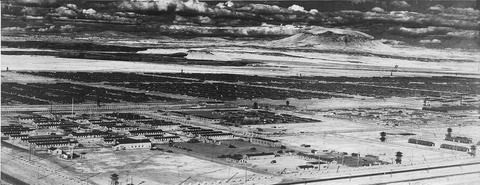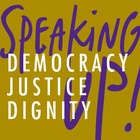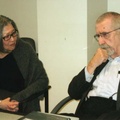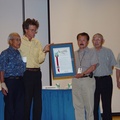Read Part 3 >>
End of Army Occupation
The WRA and the Army had very different organizational dynamics, and their relationship was often tense and fraught with disagreement. Conflict over management of the stockade climaxed on May 23, 1944, when the WRA’s Board of Inquiry approved the release of two inmates, while the Army disapproved their release. After a conference between WRA and Army officials on May 24, 1944, Director Best, by letter to Lt. Col. Verne Austin, Commander, 752nd Military Police Battalion, Tule Lake, requested complete authority to control the stockade in order to prevent future disagreements. In response, Lt. Col. Austin withdrew the Army from the stockade and discontinued patrols and all other Army activities at the Segregation Center except to guard the perimeter.1
On the same day, May 24, Army Private Bernard Goe struck 30-year old inmate James Shoichi Okamoto with his rifle butt, then stepped back and shot him at close range. Okamoto died the next day. The WDC reported that the “Japanese stories universally were that the guard had provoked the whole incident and had gone berserk.” With the growing tension between the WRA and the Army over the stockade and operation of the Center, the WRA became self-described “protectors of the evacuees against the military.” Secretary of the Interior Ickes issued a statement calling the shooting “completely unwarranted and without provocation on the part of the victim.”2 The Army court-martial of Private Goe ended in acquittal. Of the verdict, WWI veteran Joe Kurihara wrote, “To kill a man just because he was afraid of him is no excuse, yet the officers have acquitted the sentry. A cowardly shooting and a shameless verdict. This is America, hypocritical America.”3
Response to Racism: Rise of the Pro-Japan Activists
Conditions at the Segregation Center made it a hothouse to grow idealized images of Japan as a fantasy-world offering hope and salvation to the rejected, demoralized imprisoned population. The first general meeting of the newly formed group for young men, Sokoku Kenkyu Seinen-dan, was held on August 9, 1944, and three days later, 650 members, 450 parents, and 100 guests celebrated the formation of the organization. On August 17, 1944, their new petitions for repatriation and resegregation were forwarded to the Spanish Embassy and State Department, signed by 10,000 people. At the end of November, the Sokoku Kenkyu Seinen-dan changed its name to Hokoku Seinen-dan, or Young Men’s Association to Serve the Nation [Japan]. Its members were ages 15 to 35; its leaders were mostly Kibei, Japanese Americans educated in Japan, in their early 20s.4
These groups, commonly referred to as the Hokoku Hoshi-dan, consisted of the older Issei leadership group, the Sokuji Kikoku Hoshi-dan; the young men’s group, the Hokoku Seinen-dan; and the young women’s group, Hokoku Joshi Seinen-dan. They seemed to have the sanction of the WRA; their constitution stated that the government gave “legal permission in due form to our movement.”5 Their main activity appears to have been early morning marches around the camp perimeter in matching gray sweatshirts and headbands, with loud bugling. Former participants remember this as noisy dawn ritual as positive, invigorating spirit-building exercise, and an “elite” group activity that filled the vacuum of their days.6
“For the first time, I felt good about being Japanese, not in a political or loyalty sense but being part of the Japanese race,” wrote “Tom” Motomu Akashi about his participation in the Seinen-dan. He recalled being filled with a sense of belonging, teenage camaraderie, excitement, challenge, and purpose shared with other young members as they marched, exercised, and participated in sports activities. “I was not taunted, harassed, or treated as a second-class citizen. I could hold my head up high and be treated as an equal. I did not feel that I had to subordinate myself, feel inferior, or show deference to the whites as I often and subconsciously did when I was in Mt. Eden. I felt proud to be Japanese.”7
The WRA policy seemed to foster activities aimed at encouraging repatriation,8 and implicitly approved the formation and activities of the pro-Japan organizations; on October 3, 1944, it granted the Sokuji Kikoku Hoshi-dan a permit for office space, an apartment at Block 5408-D. The WRA allowed purchase of supplies and equipment to publish five issues of a Japanese language newsletter, the first of which came out November 21. Some 3,000 copies of this first issue were distributed, and the issue included news of activities, a schedule for activities, and inspirational articles to promote ethnic pride, self-respect, discipline, and hope for the future.9
The literature often characterizes the Japanese language schools as part of the pro-Japan groups’ plan to dominate and control others in the Segregation Center. Yet, according to the FBI, after segregation took place during the summer of 1943, no public schools operated at Tule Lake. The pro-Japan groups filled this vacuum by establishing Japanese language schools to educate and occupy the young people. In another instance of WRA support for pro-Japan activism, the WRA supported the Japanese language schools, assuming that the children would be going to Japan after the war and should receive a Japanese education to prepare themselves. It wasn’t until martial law was lifted in February 1944 that public schools were finally opened, placing them in the position of competing for students with the already established Japanese language schools.10
With the failure of the Coordinating Committee and the refusal of the WRA to acknowledge the concentration camp's elected leaders and release them from the stockade, there was little foundation for effective communication between the imprisoned population and the administration. The already tense and complicated situation was worsened by the continuing confusion created by three separate agencies operating at Tule Lake: the WRA, WDC, and DOJ. Each had its own policies; policies changed; and important information could easily be garbled or misunderstood or not communicated at all. In the absence of trusted and factual sources of information, inmates had little to rely on but random bits of information, opinion, gossip, and rumor.
A transcript of a meeting held December 1, 1944 with Louis Noyes, the WRA Project Attorney in the Segregation Center, makes evident the lack of information that the prisoners could expect to receive when making important, life-altering decisions. Representatives of the Issei group formed out of an earlier re-segregation committee, and now calling themselves the Sokuji Kikoku Hoshi Dan (Organization to Return Immediately to the Homeland), told Noyes that 3,000 adults wanted to renounce their citizenship, but needed information on the details of the renunciation policy. At what age could a minor legally sign the renunciation form? Could the organization reproduce the scarce DOJ renunciation forms for distribution? Were families eligible to apply for renunciation as a group? If people sent in their birth certificates, would they get them back? They sought answers to their many substantive questions, but Noyes had none because the Department of Justice had not communicated anything to him.11
Notes:
1. FBI Report, August 2, 1945, Page 182. Memo to the Director, October 4, 1944, 62-70564-303 Control of the Center. CWRIC 23206-23214. Supplemental Report WDC, page 100.
2. Supplemental Report, page 105
3. Thomas and Nishimoto, page 256-260.
4. Teruko Imai Kumei, Skeleton in the Closet, The Japanese Journal of American Studies, No. 7., 1996, page 78.
5. Kumei, page 77. “Sengen-bun [Declaration]” of Sokoku Kenkyu Seinen-dan [Young Men’s Association for the Mother Country Studies], 12 August 1944, translated from Japanese by author.
6. Oral interviews with former Seinen Dan members, Bill Nishimura, Mits Fukuda, et. al. 2002, Barbara Takei and Judy Tachibana. Also, Audrie Girdner and Anne Loftis, The Great Betrayal, page 325.
7. “Tom” Motomu Akashi, Betrayed Trust, page 199.
8. Girdner and Loftis, page 325.
9. RG 210, entry 48, box 274, files 23-25 and RG 210, Entry 48, Box 274, NND 802054, Tule Lake Relocation Files 423-425.3 Translation of Hoshi-dan Newsletter, February 15, 1945. The WRA monitored the Hokoku Hoshidan activities and concerns, and maintained a reports officer fluent in Japanese to translate issues of the Hoshidan newsletters that were printed in Japanese. Many issues of the newsletter are contained in the cited file.
10. FBI Report, August 2, 1945, page 185.
11. RG 210, Entry 48, Box 274, NND 802054, Tule Lake Relocation files 423-425.3. Notes from meeting between Mr. Noyes and the Resegregation group regarding information on the renunciation of American citizenship. Friday, December 1, 1944.
* This article was originally published in the Journal of the Shaw Historical Library, Vol. 19, 2005, Klamath Falls, OR.
* * *
* Barbara Takei will be a presenter for “The Tule Lake Segregation Center: Its History and Significance” session at JANM’s National Conference, Speaking Up! Democracy, Justice, Dignity on July 4-7, 2013 in Seattle, Washington. For more information about the conference, including how to register, visit janm.org/conference2013.
© 2005 Barbara Takei








